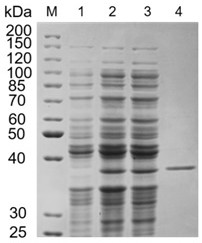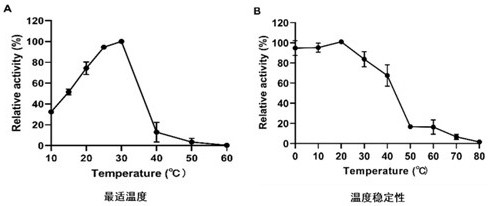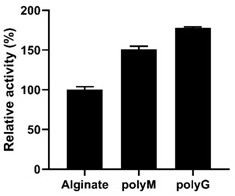An endo-type alginate lyase, its coding gene and application
A technology of alginate lyase and coding gene, which is applied in the field of endo-type alginate lyase and its coding gene and application, can solve the problems of low exonuclease activity, etc., and achieve high degradation rate, high specific activity, and broad bottom The effect of biodegradability
- Summary
- Abstract
- Description
- Claims
- Application Information
AI Technical Summary
Problems solved by technology
Method used
Image
Examples
Embodiment 1
[0043] Example 1: Preparation of endo-type alginate lyase TsAly7C
[0044] 1. Cloning and acquisition of endo-type alginate lyase TsAly7C coding gene
[0045]The full-length amino acid sequence of the endo-type alginate lyase TsAly7C provided by the present invention is shown in SEQ ID No.7. The full-length sequence of endo-type alginate lyase TsAly7C coding gene (SEQ ID No.1) was used as the template of PCR reaction, and the following primers containing pET-24a homology arms were used for PCR amplification:
[0046] F: 5'-TAAGAAGGAGATATACATATGGGCTCAACAGCACCAAATAACG-3' (SEQ ID No.2);
[0047] R: 5'-GTGGTGGTGGTGGTGCTCGAGTTCTGGTTTAGTTGCGTCACTTAATA-3' (SEQ ID No. 3).
[0048] The PCR reaction was carried out according to the following conditions: pre-denaturation at 95°C for 3 min; denaturation at 95°C for 15 s; annealing at 58°C for 15 s; extension at 72°C for 1 min, for a total of 28 cycles, followed by extension at 72°C for 5 min. After the obtained PCR product is sequenced...
Embodiment 2
[0059] Example 2: Enzymatic properties of endo-type alginate lyase TsAly7C
[0060] 1. Effect of pH on endo-alginate lyase TsAly7C
[0061] (1) Add 100 μL of an appropriate concentration of alginate lyase TsAly7C to 900 μL of 0.3% alginate substrate (20mM PB buffer, pH=8.0), react in buffers with different pH for 10 min, and measure with a spectrophotometer A 235 Values, taking the highest enzyme activity as 100%; the buffer used was 50 mM Na 2 HPO 4 -NaH 2 PO 4 (pH6.0~8.0), glycine-NaOH (pH8.6~10.6), Na 2 HPO 4 - Citric acid (pH3.0~8.0), Tris-HCl (pH7.05~8.95), calculate the relative enzyme activity of endo-type alginate lyase TsAly7C under different pH conditions. The result is as figure 2 As shown in A, the endo-alginate lyase TsAly7C is suitable for the reaction pH of 7.7-8.9, and has the highest enzyme activity at pH 8.0.
[0062] (2) Store the pure enzymes at appropriate concentrations in the above-mentioned different pH buffers at 4 °C for 12 h, mix 100 μL wit...
PUM
| Property | Measurement | Unit |
|---|---|---|
| molecular weight | aaaaa | aaaaa |
| molecular weight | aaaaa | aaaaa |
Abstract
Description
Claims
Application Information
 Login to View More
Login to View More - R&D
- Intellectual Property
- Life Sciences
- Materials
- Tech Scout
- Unparalleled Data Quality
- Higher Quality Content
- 60% Fewer Hallucinations
Browse by: Latest US Patents, China's latest patents, Technical Efficacy Thesaurus, Application Domain, Technology Topic, Popular Technical Reports.
© 2025 PatSnap. All rights reserved.Legal|Privacy policy|Modern Slavery Act Transparency Statement|Sitemap|About US| Contact US: help@patsnap.com



